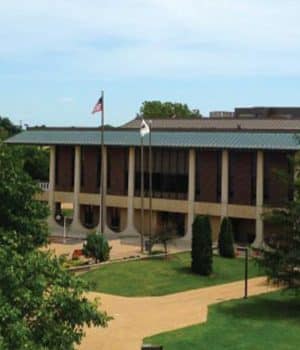
A donation to the Highland Community College Foundation by Fred and Carol Redmore was used to purchase a Thermo Scientific Nicolet iS5™ infrared spectrometer for Highland’s Chemistry lab. Fred Redmore taught Chemistry at Highland for more than 40 years, and Carol Redmore taught English.
Spectroscopy is the study of the interaction of light and matter. Chemists commonly use infrared spectroscopy in their chemical investigations. In some ways, the bonds that hold atoms together in molecules can be reasonably modeled as springs. The springs can be made to bend and stretch with infrared radiation. The infrared spectrometer measures the intensity of infrared radiation applied and compares it to the infrared radiation that passes through the sample. Different bonds have different characteristic absorptions of radiation. From the different infrared absorptions, investigators can piece together the structural features of the molecules.
“The donation came at the perfect time as our previous instrument ran MS-DOS 3.0 and used floppy disks for data storage,” said John Sullivan, Highland Chemistry instructor. “The new instrument is a current generation and is used in many local workplaces for analysis and quality control of products.”
Daniel Creuzer, a Highland student planning to go into the medical field, shares working with the spectrometer on an Honors Program project provided a meaningful additional path for him to learn data gathering.
“I had a lot of fun working on the project, and I’d totally do it again,” Creuzer said. “John Sullivan was an excellent mentor during the project. He provided hints during the project that allowed me to find the answers myself without explicitly telling me what I had to do. For example, I learned Beer’s law quite a bit ahead of when it was presented in the normal class materials, and that helped me understand what kind of information I was supposed to be getting.”
He adds: “As for what I learned, Beer’s law is a good example, but something more important was that the data gathering and analysis process clicked for me over the course of the project. Throughout the semester, and even the next one in General Chemistry II, Sullivan always tried to hammer this point home about why it was important and how commonly you see it in the laboratory, and why things were always reduced to some kind of linear form.”
For more on Highland’s Chemistry program, visit highland.edu.
